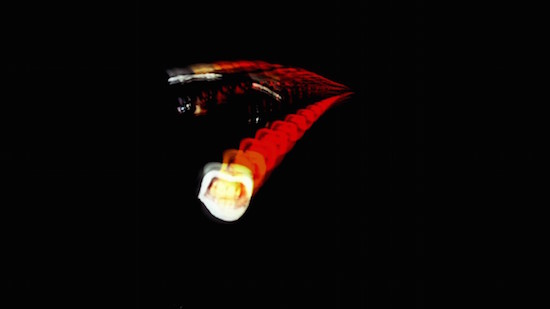WaqWaq Kingdom, the Berlin and Leipzig trio comprised of King Midas Sound’s Kiki Hitomi, Shigeru Ishihara (otherwise known as DJ Scotch Egg) and Andrea Belfi, have unveiled a new video for ‘Step Into A World’ from their latest album, Shinsekai.
The track features a spectral vocal from Drum Eye’s Kathy Alberici and is a reimagining of KRS One’s 1997, Blondie-sampling classic of the same name.
tQ caught up with the trio to talk about the track and their new album and you can read the result of that chat below.
The trio play live alongside Gonjasufi at London’s Arch Space on May 9 and 10. You can find more information on those shows here while you can purchase their latest album here.
‘Step Into A World’ seems a fitting choice for a cover to put on this album given Shinsekai’s translation to mean “New World”. Was there a particular reason you decided to put this track on the album?
Kiki Hitomi: This track started its life as a remix for maverick beat-producer Walter Gross. Shigeru Ishihara (DJ ScotchEgg) was working on it at the same time as he was producing a lot of the tracks from Shinsekai, so it naturally ended up inhabiting the same sound-world as much of the WaqWaq material. As the album started to take shape, so did the imagination of WaqWaq Kingdom, the fantasy island that the band inhabits. ‘Step Into A World’ invites you to leave your reality behind, and enter into the multicoloured dimension of WaqWaq Kingdom.
The video teaser that coincides with the track is suitably glaring and hypnotic. In fact, the whole album gives the impression of being suitable for visual accompaniment. What can you tell us about the videos we’ve seen so far?
After the album came together track by track we realised it had this very strong hypnotic soundtrack quality about it. That’s when we decided to explore the video side of things more. My background is visual arts and graphic design, and I also had experience from the videos we did for King Midas Sound, or for Spaceape which was shot in my bathroom – I did the painting on Stephen’s body.
‘Love Game’ was the first video we did. Zoya Bassi, who already did the floating Japanese pussy logo video for NoinoNoinoNoino’s ‘Wash Me Away’, was experimenting with some very interesting lighting effects on DJ Die Soon’s face which I liked, so we came up with the idea of warping all those faces together, from kids to grown ups to a dog, because they all share the suffering of the eternal love game.
The Shinsekai album teaser was made from leftover and almost forgotten material from the Love Game shooting, which was so trippy and simply worked great with the music from ‘I Would Like To Let You Go’. Then our brilliant cover artist Simon Fowler sent some footage of how he hand-carved the sleeve image by hand. We already knew about the Hanga-technique and printing style, probably best known from Hokusai’s ‘The Great Wave Off Kanagawa’, but seeing how it was actually done by taking a knife in your hand and painstakingly carving out each tiny line over days and days to shape this amazing piece of art blew our mind. Somehow those images worked very well with the track ‘Bird’ from the album, so we had to do something with it.
Finally Kathy Alberici, who did the track ‘Step Into A World’, teamed up with long-term collaborator, Federico Nitti. Federal creates unique visual worlds combining video and coding. He created some bespoke motion-tracking feedback effects and manipulated them by hand.
The sound of the Trimba that permeates the album adds so much to its vibrancy and colourful dynamic. Was the decision to incorporate it into the album Andrea’s idea? Was merging experimentation among your individual styles something that you found important?
AB: The Trimba is somehow the starting point of WaqWaq Kingdom as a project. When Shigeru Ishihara (DJ ScotchEgg) and I decided to do something together, I recorded some Trimba rhythms, and then Shige started composing the music around them. We then had the first two songs: ‘I Would Like To Let You Go’ and ‘Love Game’.
The Trimba has the special sound that includes characteristic of percussion from all over the world: Cuba, Africa, America, Middle East. It really gives a drive to the music we do, especially when it’s blended together with Shige’s hectic electronics and Kiki’s spacey voice. The fact that the three of us have different backgrounds and strong individualities, inspired us to explore territories we never tried to walk trough ourselves as solo artists. Everyone of us brought really different elements into the music.
Between the album title’s reference to an area of poverty in Osaka and your reference to WaqWaq Kingdom’s attempts to “save the world”, it seems there may be a sonic political message to this record. Is this the case?
Right now the world is changing on a big scale, the old systems simply seem to stop working, the seams are coming apart everywhere. The Shinsekai part of Osaka, my hometown, is a very good image for something that happened all over the planet: designed with good intend as "New World" for people living and being entertained in the future, the whole thing perverted over the years as 20th century capitalism ran completely free, with all it’s downsides, and took over the original good idea.
But there’s also hope, which comes down to the positive energy and passion within people, which is best translated as "Wa-ku Wa-ku". This is the only way forward to find a new and better path. So we tried to find a sonic landscape to illustrate that process of an old world ending and a new world starting without being too bleak about it, hopeless or whiny. We’re not and most people aren’t and they will move on, so hopefully this album can give them some positive energy to do just that.



